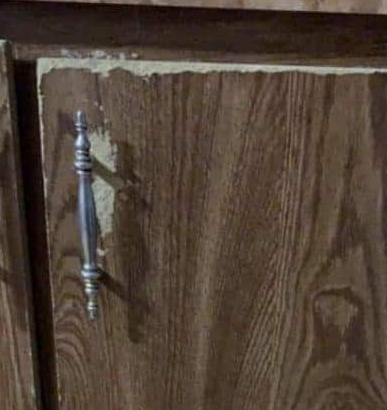Only Peeling
 Between the laminate and substrate, slip a corner of sandpaper and gently scuff up the wood or particle board.
Between the laminate and substrate, slip a corner of sandpaper and gently scuff up the wood or particle board. This would eliminate any excess adhesive and make it easier for the laminate to be kept in place by the new adhesive.
Between the substrate and the laminate, squirt a tiny amount of waterproof adhesive.
How can you get the veneer cabinets removed?
With a utility knife, score the veneer surface in many places. With a towel, clean a mixture of equal parts of white vinegar and water on the surface. Let the vinegar and water soak in the veneer, then try using the putty knife to pry the veneer up.
How do I strip adhesive from cabinets in the kitchen?
Mix a few drops of dish soap with the solution in around 2 cups of warm water.
To remove surface dirt and dust, soak a sponge in soapy water and wipe down the cupboards.
Soak the sponge in clean water, including around the hinges, knobs and handles, and thoroughly rinse the cabinets.
How is it possible to strip laminate from wood?
In the crevice between the laminate and the wood backing, gently insert the tip of your 5-in-1 putty knife. Pry apart the two surfaces, releasing 1/8 to 1/4 inch at a time from the adhesive. To avoid damaging the laminate, take your time and work slowly.
How to Repair a Cabinet Door with Peeling Laminate
Unscrew the hinges with a screwdriver from the drawer.
Lay the door flat and peel the laminate back as far as it will go with your fingertips.
Using a small paintbrush to apply solvent-based, waterproof contact cement to the exposed core as well as the underside of the laminate surface that you have peeled away.
Is it possible to peel laminate off cabinets?
The laminate can be stripped off the cabinets and the pressed wood can be painted. The downside is that when you pull the laminate from the wood, the pressed wood, or particle board, can flake off. This results in an uneven surface before adding paint that must be patched and sanded.
Should cabinets with laminate be refaced?
Refacing kitchen cabinets may be "superficial," but there are drastic effects and savings. Covering the exposed frames with a thin veneer of real wood or plastic laminate means refacing the kitchen cabinets. To fit or complement the fresh veneer, doors and drawer fronts are replaced.








 From heating and cooling to electronics and appliances, it takes a lot of energy to power our daily lives. Our homes use 37 percent more energy today than they did in 1980. But without energy efficiency -- through technology innovation and federal energy conservation standards -- this number would be a lot higher. In fact, even though our total energy use has grown, our energy use per household is down about 10 percent, despite that our homes are larger and contain more devices.
From heating and cooling to electronics and appliances, it takes a lot of energy to power our daily lives. Our homes use 37 percent more energy today than they did in 1980. But without energy efficiency -- through technology innovation and federal energy conservation standards -- this number would be a lot higher. In fact, even though our total energy use has grown, our energy use per household is down about 10 percent, despite that our homes are larger and contain more devices.



